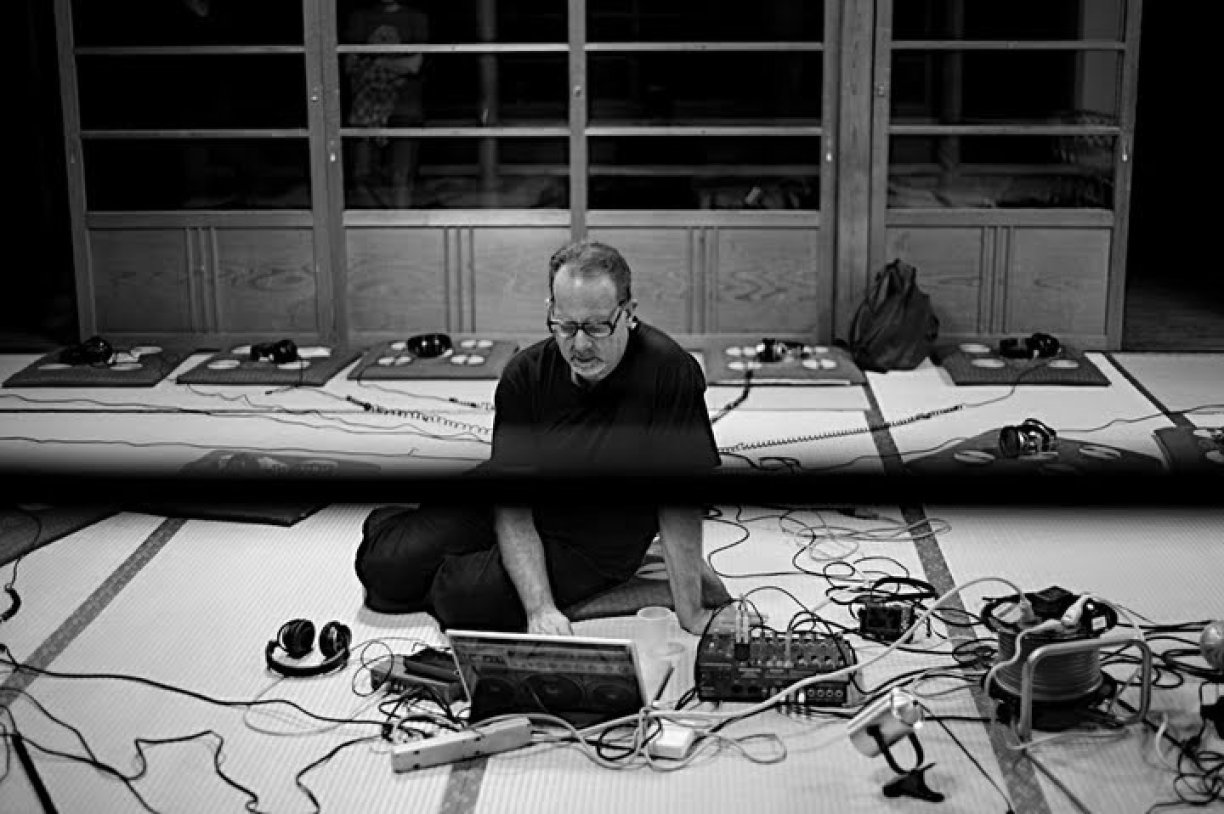Friday, March 2nd, ISSUE presents an evening of overlapping improvisations between computer music pioneer Carl Stone, composer and performer Ned Rothenberg, and Tokyo-based vocalist and cross-media artist Ami Yamasaki. While Stone and Rothenberg have performed together previously in Japan over their 35 year-long friendship, this will be their debut collaborative performance in New York. Further, the evening is a first meeting between Stone, Rothenberg, and Yamasaki, an encounter with the inevitable alchemy of skilled improvisors having an initial encounter.
An electronics prophet with 40 years of pioneering work with the possibilities of digital synthesizers, samplers and effects, Carl Stone’s practice predicts the variable techniques of contemporary computer music, serving as an uncanny precursor for the majority of today’s computer-driven methods. Before many saw the flexibility of the computer as an instrument, Stone developed his own idiosyncratic take on sonic bricolage using palettes of eastern-tuned scales, processed vocals, and pop samples to conjure majorly distinct, angular, intriguing arrangements. Within this vocabulary, Stone’s adaptability as an improviser and rigor as a composer is singular, with the LA Times describing him as ”the one who has always performed in nightclubs as well as concert halls, for spiky-haired punks as well as the PhD-and-ponytail set. He composes for the computer, not the orchestra; he plays the microprocessor the way Maurizio Pollini plays a Baldwin.”
With parallel focus, Ned Rothenberg’s engagement with wind instruments as melodic, rhythmic and harmonic engines is celebrated particularly with regard to his circular-breathing techniques and experiments with overtone manipulation and polyphony. He shares the restless eclecticism of colleagues like John Zorn and Anthony Braxton, with a particular interest in the more painterly shades of contemporary Japanese classical music. As writer Glen Hirshberg describes, “what renders Rothenberg more approachable and, in the end, more significant than many of his peers is the serenity at the heart of his fiercest playing.”
Ami Yamasaki’s vocal technique is at-once concrete and direct, but conveyed with a lyricism that runs as a consistent thread across her creative work -- spanning installation, performance, visual art, film, and writing. A recent 2017 Asian Cultural Council grantee, Yamasaki’s varied practices and installations often conceptualize the voice as physical phenomenon that exists externally from our bodies -- existing not only as a vibration that shakes the air, but an entity with its own embodiment once uttered.
Carl Stone is one of the pioneers of live computer music. He studied composition at CalArts with Morton Subotnick and James Tenney and has composed electro-acoustic music almost exclusively since 1972. When New Music was exiting the loft scene of the 1970s and entering the more commercial realm of the 1980s, Stone guided his art through that transition period by fusing his compositional ambitions with systems of live performance that were simultaneously pop savvy, commercially suicidal, and technologically forward-thinking. He moved away from pure electronic sound and was among the vanguard of artists incorporating turntables, early digital samplers, and personal computers into live electronic music composition. An adopter of the Max programming language while it was still in its earliest development at the IRCAM research center, Stone continues to use it as his primary instrument, both solo and in collaboration with other improvisers. In addition to his work as a composer, Stone served as Music Director of KPFK-FM in Los Angeles from 1978-1981, director of Meet the Composer California from 1981-1997, and President of the American Music Center from 1992-1995. He currently divides his time between Los Angeles and Japan, where he is a faculty member of the Department of Media Engineering at Chukyo University in Japan.
Composer/Performer Ned Rothenberg has been internationally acclaimed for both his solo and ensemble music, presented for the past 33 years on 5 continents. He performs primarily on alto saxophone, clarinet, bass clarinet, and the shakuhachi - an endblown Japanese bamboo flute. His solo work utilizes an expanded palette of sonic language, creating a kind of personal idiom all its own. In an ensemble setting, he leads the trio Sync, with Jerome Harris, guitars and Samir Chatterjee, tabla, works with the Mivos string quartet playing his Quintet for Clarinet and Strings and collaborates around the world with fellow improvisors. Recent recordings include this Quintet, The World of Odd Harmonics, Ryu Nashi (new music for shakuhachi), and Inner Diaspora, all on John Zorn's Tzadik label, as well as Live at Roulette with Evan Parker, and The Fell Clutch, on Rothenberg’s Animul label.
Ami Yamasaki is a vocalist and cross-media artist from Tokyo. Yamasaki creates installations, performance pieces and directs films. With primal vocals and movement, she explores the possibilities of a deeper understanding towards the mechanism of the world. In 2017, she was invited to New York by Asian Cultural Council as its grantee. She mainly performs in Japan, but has recently staged work in the U.S at “Sounds to Summon the Japanese Gods” at Japan Society in 2016. Her main solo show have included “Signs of voices” (2016, Kyoto Art Center, Kyoto), and group shows include “Tokyo Experimental Festival vol.09 ”(2014, Tokyo Wonder Site, Tokyo), “Exchange-planting a seed” (2013, Aomori Contemporary Art center, Aomori) and “Sonic City 2013 Liquid Architecture” (2013, RMIT, Melbourne). Her work is diverse and prolific; ranging from the collaborations with Keiji Haino, Yasunao Tone, Akira Sakata, and Ryuichi Sakamoto, workshops at The National Museum of Art Osaka, Arts Maebashi, and Sapporo City Kojo elementary school, as well as television and film appearances as a narrator and voice foley for “MORIBITO Ⅱ” (NHK, 2017) and Hayao Miyazaki’s latest short film (Ghibli, 2017). She presented a TEDx talk at TEDxTokyo yz in 2016.

